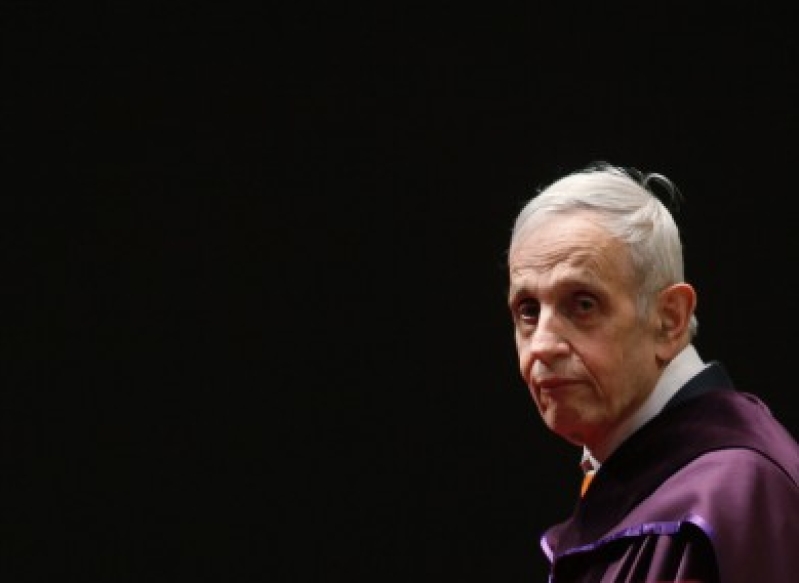
John F. Nash Jr., 86, was tragically killed in a vehicular crash on Saturday. The Nobel Prize-winning mathematician was riding in a taxi with his wife Alicia, 82, near Monroe Township.
According to New Jersey State Police, the taxi driver lost control of the vehicle when attempting to pass up another car. The vehicle crashed into a guard rail, throwing the couple outside. Both Nash and Alicia were pronounced dead at the scene.
Taxi driver, Tarek Girgis, did not suffer life-threatening injuries but was airlifted to the Robert Wood Johnson University Hospital. Currently, the accident is under investigation by the police.
Nash's Game Theory Explained
Many sources erroneously credit John Nash for creating the game theory even though he was not the theory's inventor. Rather, the supposition evolved from discourses by various mathematicians throughout history. In the 1950s, John von Neumann and Oskar Morgenstern developed the argument to its more modern form.
Nash separated himself from his forbearers by advancing the principle beyond a competition based on having one loser and one winner. Alternately, his iteration of the game theory involves all players either winning or losing.
New York Times' Kenneth Chang recently offered a simpler explanation for Nash's work by creating a hypothetical scenario involving two arrested criminals.
Both prisoners can either choose to maintain silence or confess, Chang writes. If one perpetuator were to confess, he would only be imprisoned for 1-8 years while his partner serves 10 years. Should the criminals remains silent, both may be charged for a lesser crime due to lack of evidence - possibly being released in 1 year.
Still, it is less likely the prisoners will remain silent because neither one knows each other's intentions. Under Nash's theory, it is best for the prisoners to confess. Should one criminal remain silent, he will put himself under greater risk - the consequences being a longer prison sentence.
Descent into Madness, and Rehabilitation
Nash is widely known as one of the greatest mathematical minds of the 20th century, and a sufferer of paranoid schizophrenia. Still, there are major differences between A Beautiful Mind's depiction and Nash's actual experience.
According to CNN, the film shows Nash gradually accepting medication. Later, the protagonist decides to stop treatment after realizing his visions are not real. The real Nash avoided taking pills long before coming to that epiphany.
Still, Nash said in a 1994 interview that disturbed people never fully recover to "what you could call mentally well". He goes on with saying that such individuals live "a form of life that's for people who are not really highly function-able."
Romantic Life: Real Life vs. Hollywood
The 2001 film placed much emphasis on the late mathematician's romantic life. For instance, the movie depicts Alicia Larde as his first and only true love.
In reality, Nashi began his first love affair with Massachusetts nurse Eleanor Stier in 1952. When Stier became pregnant with their son, John David, Nash left Eleanor. He reportedly refused to bear financial responsibilities for the boy. Eleanor was forced to hire an attorney in 1956 to compel him to pay child support. Throughout the decades, Nash would have an on-and-off relationship with John David Stier. The Slate quoted the estranged son as saying, "Having a mentally ill father was rather disturbing."
Nash was arrested in California in 1954 for indecent exposure in a Santa Monica bathroom. He was apparently engaging in a homosexual liaison, which was illegal in California at the time. The arrest resulted in Nash losing his job at the RAND Institute.
John Nash married MIT graduate Alicia Lopez-Harrison de Larde in 1957. By this time, Nash had received a tenured position at the Massachusetts Institute of Technology. His wife was a naturalized U.S. citizen from El Salvador. Even though Nash was an atheist, the couple married in a Roman Catholic church.
Alicia was pregnant with their only child when Nash began showing signs of mental-illness. Their son, also named John, was born after Nash was hospitalized for schizophrenia. The couple divorced in the early 1960s, but eventually reconciled. In 1970, Nash moved in with Alicia as one of her boarders. They remarried in 2001, years after Nash won the Nobel Prize.
John Nash is survived by his two sons, John Daivid Stier and John Charles Martin Nash. John Charles, like his father, suffers from paranoid schizophrenia.
According to the New York Daily News, John Charles Nash, 55, was dressed in a long-sleeved shirt and carrying a birthday card and a pen as he walked into his home, refusing to speak with reporters.
'He's in deep grief, he's in great distress,' said Dr. Debra Wentz, a family friend who heads the New Jersey Association of Mental Health Agencies.
'He just needs some time and space. It is a shock, but he's dealing with it well.







